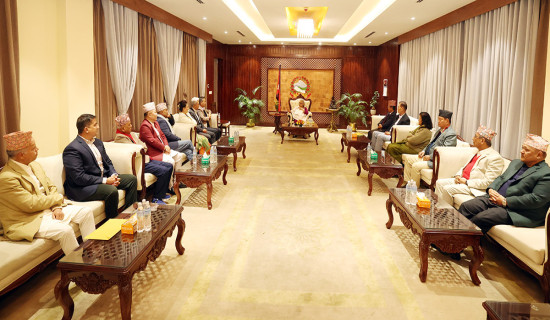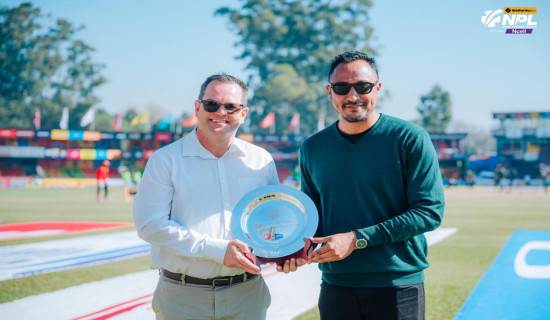- Sunday, 30 November 2025
Take Safety Measures Against COVID
New cases of COVID-19 are once again being confirmed in Nepal. On June 6 and 7, several individuals returning from India were identified as infected at the Health Emergency Operation Centre in Sudurpaschim Province. The Epidemiology and Disease Control Division has reported that many returnees, primarily from the Kanchanpur, Achham and Kailali districts, tested positive for COVID-19. These individuals exhibited symptoms such as fever and cough. They were tested using rapid diagnostic kits at the Trinagar border point in Kailali, as well as other entry points where a few more cases have also been detected. Authorities have been informing the public of these findings.
"Although there is no need to panic, it is essential that we begin taking precautions to protect our most vulnerable populations, including infants and the elderly, from the new strains of the coronavirus entering the country," says Dr. Nastu Sharma, CEO of Manmohan Memorial Hospital. He advises that all the safety protocols adopted during the COVID-19 pandemic should be reinstated. These include regular handwashing, wearing masks, maintaining physical distance, and avoiding crowded areas, especially for senior citizens and babies.
Surge of COVID cases
COVID-19 cases are also rising in India. Recently, within 24 hours, the country reported 564 new infections and seven deaths. According to India’s Ministry of Health and Family Welfare, as of January 2025, active COVID-19 cases reached 4,866, with 51 deaths recorded this year. The World Health Organisation (WHO) has reported a sharp increase in COVID-19 cases in several countries in the South-East Asia region. As of June 1, 2025, Bangladesh, India, Myanmar, and Thailand are experiencing a noticeable surge. Between May 26 and June 1, Bangladesh reported 47 cases; India, 3,961 cases and 20 deaths; Myanmar, 17 cases and Thailand, 53,614 cases with five deaths.
Globally, WHO notes that since February 2025, SARS-CoV-2 case have been rising, with test positivity rates reaching 11 per cent levels not seen since July 2024. This increase is particularly evident in the Eastern Mediterranean, South-East Asia, and Western Pacific regions. Current COVID-19 vaccines continue to offer protection against severe illness and death. WHO's Technical Advisory Group on COVID-19 Vaccine Composition (TAG-CO-VAC) continues to monitor virus mutations to ensure vaccine effectiveness. While people may wait for newer, variant-specific vaccines, WHO stresses the importance of vaccinating high-risk groups immediately with any available approved vaccine, rather than delaying.
After the formal declaration of the end of the Public Health Emergency of International Concern (PHEIC) in May 2023, the WHO reported that countries have adopted varied strategies to manage the ongoing threat of COVID-19. Nepal, having experienced significant challenges during the pandemic, should act swiftly even if the current threat does not appear as severe. The government must begin public outreach campaigns using various media platforms to promote awareness and preparedness. Proactive measures can help avoid a larger outbreak.
Global health officials have identified the XBB.1.5 variant, a highly contagious Omicron subvariant, as responsible for the majority of new infections. Nicknamed the “Kraken” strain, it is believed to be about five times more contagious than earlier Omicron variants. It is also spreading among vaccinated and recently recovered individuals. The symptoms — such as joint pain, headaches, sore throat, backache, pneumonia, and a significant loss of appetite — are often mistaken for seasonal flu, making detection more difficult.
The Department of Health Services of Nepal lacks resources for rapid test kits in the border area. This must be increased immediately. It is also important to start the rapid tests in the inner area of the country, which does not have an open border with India. In the Kathmandu Valley, people are being infected with cough, sneezing and fever. But most take it as the cold and flu symptoms. With the wedding season underway, numerous social events such as weddings, thread ceremonies, and rice-feeding ceremonies are being organised. These gatherings often bring together large groups of family and friends. In many cases, parties with hundreds of guests are being held to celebrate festivals and other social occasions. Most of the time, both hosts and guests attend these events without wearing masks.
Heightened concerns
The concern is further heightened by the fact that the new Omicron variant may not present with the typical symptoms. As a result, many individuals infected with the virus could unknowingly be participating in these gatherings and potentially spreading the infection to others. During the height of the pandemic, hospitals in Nepal had provisions in place to handle a surge in COVID-19 patients. It is now crucial to reassess the current readiness of healthcare facilities and understand how they would respond in case of a new surge. Most importantly, people’s lifestyles have largely returned to how they were before the pandemic, with little visible caution or awareness of the ongoing risks.
Given this situation, it is now advised to avoid crowds, maintain a distance of at least 1.5 meters even in open areas, wear masks, and practice regular hand hygiene. Health experts have warned that the XBB wave could be deadlier than the first wave of the pandemic. Thus, we must remain vigilant and take every possible measure to protect ourselves, our families, and our communities, especially infants, the elderly, and those with chronic health conditions.
(Sharma is a senior journalist and women’s rights advocate namrata1964@yahoo.com or on X @NamrataSharmaP.)

















